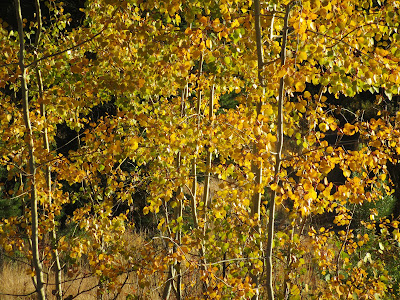I've embarked on a small project while I'm in New Zealand - to create a collection of "sketches" inspired by my travels in Africa. The parameters I set for myself are that each one will be 6" x 6", use raw edged fabrics, and be hand-stitched. I've completed the first five, and am experiencing that thing that sometimes happens when you don't know at the beginning where a piece will take you, but try out the possibilities as they occur to you, and sometimes it works and sometimes it doesn't, but the process itself, the scope for serendipitous surprises, is so engaging that the whole enterprise is a delight.
I begin each "sketch" with a piece of fabric 7" x 7", back with a piece of low-loft cotton batting the same size. For the first one I chose a piece of rusted fabric on which to build. Actually, truth be told, I started at first with a plain white fabric, but it was too daunting, so I switched it for the rusted fabric, which made a much better starting point.
Thinking back to my recent indigo pieces, I began overlapping different sized rectangles. I was thinking of the tropical trees found in some parts of Africa, and of the oceans on three sides of the continent, of the natural state of this massive land mass, before it became so populated.
But it looked too blue. Not African at all. So I added a hit of orange - thinking of the warmth of the sun, of how truly hot you can be even at the ocean. (Remembering a day in Dar es Salaam when I suddenly realized why people were walking so slowly, and I could do nothing else but return to my hotel room where a fan turned slowly overhead, making barely perceptible changes in the movement of the air, but still, it was better than being outside and moving about.)
I liked the orange but I wanted to give it a more major role. I wanted it to undergird the rest of the design. So I removed the first bit and replaced the dark greeny-blue with orange and black. This fabric made me think of the many people walking along the roadsides just about everywhere, along roads just that colour in fact. So I added the feet. Which could be my feet as I travelled or the feet of the people I met who walk so far every day just for water and firewood.
Still not happy with that blue. Too plentiful. Too available. Not the story for many, many people. So I made more changes such that the predominant colour of the piece it orangey-red. Much better.
But I want the sky in there too - a sky that is this clear hot blue. I'm thinking of the sky over the desert in Namibia - white sands and blue sky. So I try another strip and like it better.
I add one more detail - the leaves - somehow they represent hope for me. Hope that the lives of the women I worked with are at least a little easier than they were when I met them. Hope that the world doesn't give up on Africa, that new ways are found to work with the people so that things change "slowly by slowly" in a good way. And then, when I'm happy with the placement of the fabrics, I added the next layer - the stitching - which includes a few personal symbols. And I added the solid black facing, and once mounted on a small black canvas, it will be finished.
Here's the second sketch.
And the third. Each one has a story behind it, a narrative that develops as I'm working, and it helps me decide what to do next, what details might still be added, what works and what doesn't. In the process I'm remembering so many of the experiences I've had, little things that had slipped into the back of my memory without me noticing it and now are being recalled again as I work. This is good, and I'm looking forward to seeing where it takes me next. Right now I'm thinking that there will be sixteen sketches in total, but that could always change. I guess it will depend on how many stories are waiting to be told.








































